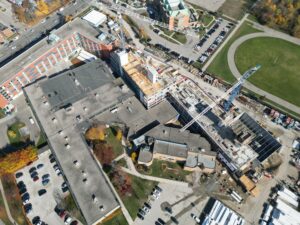Landmark arts centre pushes boundaries of sustainable design

Projects Sponsor
Built to the highest sustainability standards to achieve net-zero before 2050, the Hub will be the largest building in Canada to take a pass on natural gas. By gracing Toronto’s west end with one of the greenest developments in Canada, Humber puts sustainability centre stage.
Over the course of the last decade, the population of Humber’s Lakeshore Campus has more than doubled, and the community of staff, students, and faculty have outgrown the existing facilities. Since Humber purchased the building in 1972, several make-do renovations have kept the space usable, but some critical spaces like those housing the performing arts program had not been updated for close to 60 years.
A significant amount of deferred maintenance along with required AODA renovations needed to be done and rather than just maintain the ageing and inefficient infrastructure, Humber decided to step up instead of patching up. They decided to embark on the creation of a world-class arts and culture destination, one that would also achieve some of the highest standards in sustainable design, construction, and operation, and so The Humber Cultural Hub (HCH) was conceived.
With the Hub, the college aims to create a landmark building for its Humber Lakeshore Campus. Humber College recognizes that decarbonization is a critical component of climate action. By utilizing cutting-edge but proven green building technology, they’re creating state-of-the-art teaching and learning spaces for both media and performing arts students as well as the broader community. The Hub will provide a much-needed community resource for learning resources and performing arts in south Etobicoke.

Beyond just retiring ageing infrastructure, the college will be building additional, and much needed, student residences. They want to preserve and maintain one of the best recording studios in North America throughout the construction process, as well as ensure the existing A Building continues to be in full academic operation during construction.
That’s a tall order. Add on fulfilling net zero-carbon certification — including requirements such as a minimum of 5% of total building energy generated from a photovoltaic (PV) solar system — and it’s clear Humber had their work cut out for them.
This work included an archaeological study of the site and environs for potential impact on early Indigenous settlements near the site. Recognizing the Indigenous heritage of the land occupied by Humber College is one of the college’s priorities when building the HCH.
After a year-long review commissioned by Humber College, Integrated Project Delivery (IPD) was the delivery method chosen for the HCH project. The review compared the advantages of IPD against other traditional construction models like Stipulated Sum contracts, and Design-Build, and evaluated how it would fit within the Canadian market. IPD is a framework that offers significant sustainability benefits by avoiding waste and inefficiency throughout the design and construction process. The building owner, architect/consultant team, and construction team work collaboratively to align their interests and reduce risk.

While IPD is a well-known practice in the United States, the model is new to the Canadian construction landscape and challenges convention by requiring every member of the project team to collaborate, even prior to building design. The HCH process has produced valuable learnings that could usher IPD into the mainstream of Canadian design and construction.
Things that may be commonplace now – ground-source heat pump systems, living walls, chiller plant optimization systems, and passive cooling systems – were fringe technologies or concepts when first utilized at Humber Campuses. The HCH will continue Humber’s legacy of pushing boundaries in sustainability, through their achievements like Net Zero Carbon Building Certification and a design that eliminated the need for fossil fuel use on site. The building’s energy target of 75kWh/m2 /year is substantially lower than the average 364 kWh/m2 per year intensity of commercial and industrial buildings.

Geothermal systems are a key innovation in this project and crucial in reducing the dependence on natural gas or electricity. The system will generate up to 70-80% of the energy it needs. Solar panels will generate the equivalent of 10% of the energy required for the building. Combining these, it is estimated that 90-100% of renewable energy could run the HCH.

Mass timber structure in the Residence portion of the HCH utilizes carbon capture sourced from renewable forests to store carbon and displace high-carbon and non-renewable cement, brick, and steel from traditional construction. The very best in automated and highly efficient building systems (HVAC, lighting, and water management), and a high-performance building envelope will reduce heating costs, while the strategic use of glazing and shading will control solar heat gain and loss. This will allow the building to meet or exceed Toronto Green Standard building specifications.
The HCH will be a world-class arts and culture destination, a 365,000 sq. ft. landmark building that will transform education for the entertainment and creative industries, advancing innovation and media education.
The Humber College Hub will be the largest building in Canada to take a pass on natural gas. The only energy utilized outside geothermal and solar will be electricity. With one of the most sustainable developments in Canada, Humber College puts global best practices centre stage.













